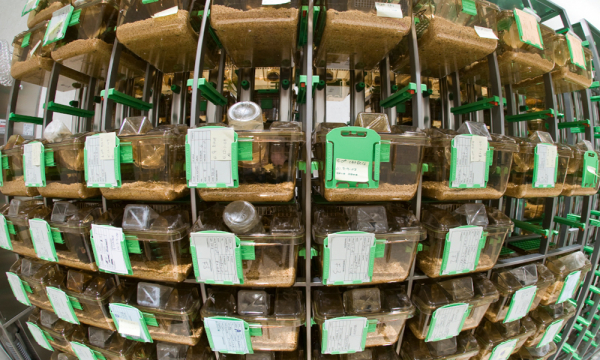The UAH animal facility
Universidad de Alcalá has the Center for Animal Experimentation (C.E.A.), one of the six units of the Center for Support to Research in Medicine and Biology, which is run by Professor Juan Soliveri de Carranza. Dr. José María Orellana, Head of Animal Welfare and Designated Veterinary at the C.E.A., tells uah.esnoticia how and what animals they work with.
- How many animals and what species can be found at the UAH Animal Experimentation Center?
The animal facility is designed to accommodate up to 6.000 small species animals and, on time and for a short space of time, some larger species, such as pork.
Since it was opened in 1992 it has hosted species as disparate as pigs, lizards, planaries, guinea pigs, zebra fish, rabbits, rats and mice, the latter being both conventional, genetically modified or immunocompromised, the most commonly used.
- What kind of research are they used for?
If we are confined to our university, there are very different and varied research, but among others we can name basic research on cancer, biomaterials, prostheses, pain, cardiology, kidney, diabetes, cirrhosis, aging, nutrition, toxicology or animal welfare.
-Do they only work with UAH researchers or can they ‘borrow’ to other institutions?
We are open not only to our researchers, but to any external institution. This enables both the UAH research groups and the animalarium, to have such important external resources at the moment.
- What makes the animalarium from the UAH different to those of other universities?
Conceptually in very little. The differences come from the species and the number of animals that are hosted in each animal, because, in general, in the case of university animalariums we must be very versatile, as there are many research groups with different needs and that we must try to cover.
This concept differs from the animal facilities of research centers because they are very specific in their research lines, such as those of the CSIC or the Carlos III Institute of Health.
- What conditions should be taken into account to ensure the welfare of these animals?
This is an indispensable aspect to be considered in an animalarium and by extension throughout the University.
All animal use is legally regulated, but if it were not, using our common sense would make us realize that we work with living beings, and that these are the weak part of their relationship with human beings. Furthermore, an animal that does not have adequate welfare will hardly give us reliable results in our research.
All projects carried out on animals must be absolutely justified and this means that, first of all, it must be shown that the experiment cannot be carried out using any other method than the animals themselves, that the smallest number of animals will be used to obtain reliable scientific results and that we will put all the means to minimize, where possible, the suffering of these animals and improve their well-being.
- So who is concerned that everything you tell us is done correctly?
The process of authorizing an animal project may last from two to three months, since before such authorization can be requested from the Community of Madrid as the competent authority, it must have been evaluated by two internal organs of the UAH: the Committee on Ethics of Animal Research and Experimentation and the Body Enabled for the evaluation of animal research projects, both of which are made up of more than twenty researchers from the University and which is chaired by the Vice-Chancellor of Research and Transference. In addition, the UAH is committed by the COSCE Transparency Agreement to inform society about the results and procedures of experiments in which animals have been used.
 |
| Mouse that is part of the UAH animal facility |
- Tell us more about this, what is the Transparency Agreement on the Use of Scientific Experimentation Animals in Spain?
It´s a document promoted by the Confederation of Scientific Societies of Spain COSCE, to which the University of Alcalá has been attached for several years, which aims to establish communication ways between the scientific community and society about when, how and why animals are used in research and the benefits that derive from this practice.
The agreement commits the signatory organizations, whose number already exceeds 140 institutions, to share information in a transparent manner and to promote communication on animal research, in order to provide all the information on the reasons available public, methods and advance in knowledge that it generates and which justifies the use of animals in scientific research.
Publicado en: Inglés
